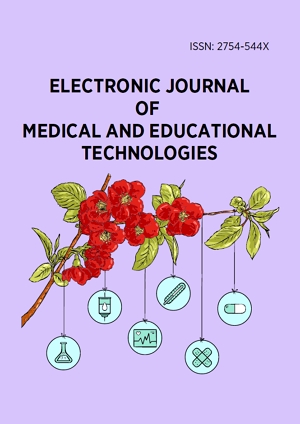Keyword: COVID-19
31 articles found.
Original Article
Knowledge and attitude towards the acceptance of vaccination against COVID-19 among healthcare professionals in Morocco
ELECTR J MED ED TE, Volume 17, Issue 2, June 2024, Article No: em2405
https://doi.org/10.29333/ejmets/14696Original Article
Perceptions about the COVID-19 disease and the vaccination of those arriving at a vaccination center are correlated with medical public health services management
ELECTR J MED ED TE, Volume 17, Issue 2, June 2024, Article No: em2404
https://doi.org/10.29333/ejmets/14440Review Article
Medical educational study burnout and job satisfaction among general practitioners and occupational physicians during the COVID-19 epidemic
ELECTR J MED ED TE, Volume 17, Issue 1, March 2024, Article No: em2402
https://doi.org/10.29333/ejmets/14299Original Article
Students perceptions of distance learning effectiveness among nursing students during the COVID-19 pandemic
ELECTR J MED ED TE, Volume 17, Issue 1, March 2024, Article No: em2401
https://doi.org/10.29333/ejmets/14249Original Article
COVID-19 vaccine acceptance prediction: The roles of students’ attitude towards science and mathematics and knowledge of COVID-19 pandemic
ELECTR J MED ED TE, Volume 16, Issue 2, June 2023, Article No: em2304
https://doi.org/10.29333/ejmets/13011Original Article
Availability of digital resources and institutional compliance with COVID-19 mitigation measures in a Nigerian university: A descriptive study
ELECTR J MED ED TE, Volume 15, Issue 4, December 2022, Article No: em2208
https://doi.org/10.29333/ejmets/12411Original Article
Examination of oxidative stress levels in saliva of people with SARS-CoV-2 infection
ELECTR J MED ED TE, Volume 15, Issue 3, September 2022, Article No: em2207
https://doi.org/10.29333/ejmets/12358Original Article
Determinants of Public Acceptance of Testing and COVID-19 Vaccines in Cameroon: A Cross Sectional Study
ELECTR J MED ED TE, Volume 15, Issue 2, June 2022, Article No: em2206
https://doi.org/10.29333/ejmets/11890Review Article
COVID-19 Second Bloom and Comfortable Lockdown in Bangladesh
ELECTR J MED ED TE, Volume 15, Issue 2, June 2022, Article No: em2203
https://doi.org/10.29333/ejmets/11537Original Article
COVID-19 Pandemic and Precautions and Risks for Institutional Normalization (In the Example of ALKU Professional Opinion)
ELECTR J MED ED TE, Volume 15, Issue 2, June 2022, Article No: em2202
https://doi.org/10.29333/ejmets/11536Original Article
Epidemiology of COVID-19 in Albania During the First Year of the Pandemic
EUROPEAN J MED ED TE, Volume 14, Issue 4, December 2021, Article No: em2116
https://doi.org/10.30935/ejmets/11274Brief Report
The Importance of Palliative Care in COVID-19
EUROPEAN J MED ED TE, Volume 14, Issue 4, December 2021, Article No: em2115
https://doi.org/10.30935/ejmets/11273Review Article
Transmission of Coronavirus (SARS-CoV-2) by Presymptomatic and Asymptomatic COVID-19 Carriers: A Systematic Review
EUROPEAN J MED ED TE, Volume 14, Issue 3, September 2021, Article No: em2110
https://doi.org/10.30935/ejmets/11060Original Article
Spreading Analysis of COVID-19 Epidemic in Bangladesh by Dynamical Mathematical Modelling
EUROPEAN J MED ED TE, Volume 14, Issue 3, September 2021, Article No: em2109
https://doi.org/10.30935/ejmets/10959Review Article
Monkeypox: A Neglected Viral Zoonotic Disease
EUROPEAN J MED ED TE, Volume 14, Issue 2, June 2021, Article No: em2108
https://doi.org/10.30935/ejmets/10911Original Article
Numerical Prediction for Spreading Novel Coronavirus Disease in India Using Logistic Growth and SIR Models
EUROPEAN J MED ED TE, Volume 14, Issue 2, June 2021, Article No: em2106
https://doi.org/10.30935/ejmets/10848Review Article
Impact of COVID-19 (SARS-CoV-2) on the Surgical Care of Patients and Surgical Training in Africa
EUROPEAN J MED ED TE, Volume 14, Issue 2, June 2021, Article No: em2105
https://doi.org/10.30935/ejmets/10810Review Article
Protective Measures of Healthcare Professionals to Face COVID-19: Case of China and Morocco
EUROPEAN J MED ED TE, Volume 14, Issue 1, March 2021, Article No: em2101
https://doi.org/10.30935/ejmets/9307Review Article
Mobile Health Technology (Mhealth) in Combating COVID-19 Pandemic: Use, Challenges and Recommendations
EUROPEAN J MED ED TE, Volume 13, Issue 4, December 2020, Article No: em2018
https://doi.org/10.30935/ejmets/8572Review Article
Combating COVID-19 Pandemic in Bangladesh: A Memorandum from Developing Country
EUROPEAN J MED ED TE, Volume 13, Issue 4, December 2020, Article No: em2017
https://doi.org/10.30935/ejmets/8571Original Article
Effect of COVID-19 on the Mental Health and Social Activities of Healthcare Students in Southwestern Nigeria
EUROPEAN J MED ED TE, Volume 13, Issue 4, December 2020, Article No: em2015
https://doi.org/10.30935/ejmets/8569Review Article
Comparison between symptoms of COVID-19 and other respiratory diseases
EUROPEAN J MED ED TE, Volume 13, Issue 3, September 2020, Article No: em2014
https://doi.org/10.30935/ejmets/8489Original Article
Knowledge, Attitude, and Awareness Related to COVID-19 Pandemic Among the Public, Saudi Arabia: A Cross-Sectional Descriptive Study
EUROPEAN J MED ED TE, Volume 13, Issue 3, September 2020, Article No: em2013
https://doi.org/10.30935/ejmets/8488Original Article
Mental Health and Psychosocial Implications on the Medical Workers during the Pandemic COVID-19 Outbreak in Pakistan: An Empirical Review
EUROPEAN J MED ED TE, Volume 13, Issue 3, September 2020, Article No: em2012
https://doi.org/10.30935/ejmets/8374Research Article
Intention to Reserve Food During COVID-19 Pandemic Among Bangladeshi Internet Users: Based on Theory of Planned Behaviour
EUROPEAN J MED ED TE, Volume 13, Issue 2, June 2020, Article No: em2010
https://doi.org/10.30935/ejmets/8299Review Article
Risk of COVID-19 for Patients with Cancer: A Narrative Overview
EUROPEAN J MED ED TE, Volume 13, Issue 3, September 2020, Article No: em2008
https://doi.org/10.30935/ejmets/8257Original Article
Assessing the Perceptions and Awareness of COVID-19 (Coronavirus) in Cameroon
EUROPEAN J MED ED TE, Volume 13, Issue 2, June 2020, Article No: em2007
https://doi.org/10.30935/ejmets/8236Review Article
The Convalescent Serum for Treatment of COVID-19 Infection: Review
EUROPEAN J MED ED TE, Volume 13, Issue 1, March 2020, Article No: em2005
https://doi.org/10.30935/ejmets/8016Original Article
On the Stabilization of the Spread of the Coronavirus (COVID-19) Pandemic in the World
EUROPEAN J MED ED TE, Volume 13, Issue 1, March 2020, Article No: em2004
https://doi.org/10.30935/ejmets/8015Original Article
Spreading of the Novel Coronavirus (COVID-19): Mathematical Modeling in Malaysia Perspective
EUROPEAN J MED ED TE, Volume 13, Issue 1, March 2020, Article No: em2002
https://doi.org/10.30935/ejmets/8013Review Article
COVID-19 in Algeria: Chronology and Evaluation of Preventive Actions
EUROPEAN J MED ED TE, Volume 13, Issue 1, March 2020, Article No: em2001
https://doi.org/10.30935/ejmets/8012
